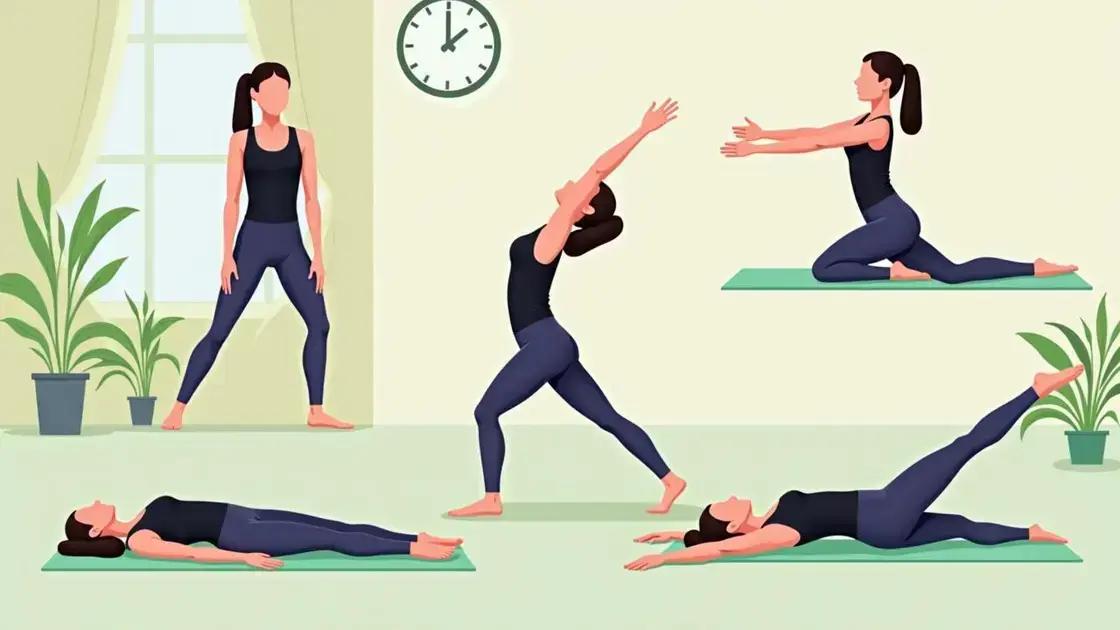The role of flexibility training in healthy aging is crucial as it enhances mobility, reduces pain and stiffness, improves balance, and promotes overall well-being. Incorporating regular flexibility exercises into your routine can lead to significant health benefits and help maintain independence as you age.
Flexibility training plays a crucial role in healthy aging, allowing older adults to maintain their mobility and independence. As we age, our muscles and joints can become stiff, making daily activities more challenging. In this article, we will explore the benefits of flexibility training, how to incorporate it into your routine, and provide tips for effective practice. Understanding these aspects can help you stay active and promote longevity.
Understanding Flexibility Training

Flexibility training refers to exercises and practices aimed at enhancing the range of motion in your joints and muscles. As we grow older, our bodies naturally experience a decrease in flexibility, which can lead to stiffness, reduced mobility, and increased risk of injury. By incorporating flexibility training into your routine, you can counteract these effects, thus supporting healthy aging.
There are several key types of flexibility training, including:
- Static stretching: Involves holding a stretch for a set period of time, usually between 15 to 60 seconds. This method is effective for improving overall flexibility.
- Dynamic stretching: Involves controlled movements that increase your range of motion. It is often used as a warm-up to prepare the body for physical activity.
- Ballistic stretching: Involves bouncing movements to push the muscles beyond their normal range of motion. This type may not be suitable for everyone, as it can increase the risk of injury if not done correctly.
- PNF stretching: Proprioceptive Neuromuscular Facilitation involves a combination of stretching and contracting the muscle group being targeted. This method can lead to significant gains in flexibility.
Why is flexibility training important? It helps maintain joint health, improves balance, and enhances athletic performance. Furthermore, regular flexibility exercises can aid in relieving muscle tension and prevent injuries, which are common as we age. Practicing flexibility exercises keeps our body limber and helps to improve our overall quality of life.
Benefits for Healthy Aging

Flexibility training offers numerous benefits that can significantly enhance healthy aging. Here are some key advantages:
- Improved Mobility: Regular flexibility exercises help maintain and even improve the range of motion in joints. This is crucial for performing daily activities easily.
- Reduced Pain and Stiffness: Flexibility training can alleviate muscle tension and stiffness. This leads to less discomfort while moving and lowers the risk of chronic pain conditions.
- Enhanced Balance: Improved flexibility contributes to better stability and balance. This reduces the risk of falls, which can be a significant concern for older adults.
- Better Posture: Flexibility exercises promote better spinal alignment, which can lead to improved posture. Good posture helps prevent back pain and other related issues.
- Increased Blood Circulation: Stretching exercises enhance blood flow to muscles and joints. This is beneficial for overall cardiovascular health and can promote healing.
- Stress Relief: Engaging in flexibility training can reduce stress and promote relaxation. This is important for mental health and emotional well-being.
Incorporating flexibility training into daily routines can lead to long-term benefits, allowing older adults to maintain their independence and engage in activities they enjoy. With these advantages, flexibility training acts as a cornerstone for a healthier, more active lifestyle.
Incorporating Flexibility into Your Routine

Incorporating flexibility training into your daily routine can be easy and enjoyable. Here are some practical tips to help you get started:
- Start Small: Begin with just a few minutes of stretching each day. Gradually increase the duration and intensity as you become more comfortable.
- Choose a Time: Find a specific time that works for you, whether it’s in the morning, during lunch, or before bed. Consistency will help you develop a habit.
- Make it Convenient: Keep a yoga mat or stretch strap nearby to encourage spontaneous stretching. This could increase your chances of incorporating flexibility exercises into your day.
- Use Online Resources: Various online videos and apps offer guided stretching routines. These can help you follow along and ensure you’re using proper techniques.
- Join a Class: Consider enrolling in a local or online class focused on yoga, Pilates, or tai chi. These classes often incorporate flexibility exercises and can be a great way to learn.
- Set Goals: Write down specific flexibility goals, such as reaching a particular stretch or improving your balance. Tracking your progress can encourage you to stay committed.
By making flexibility training a regular part of your routine, you can reap the numerous benefits it offers for healthy aging. It’s never too late to start; your body will thank you!
Tips for Effective Flexibility Training

Effective flexibility training is essential for gaining the maximum benefits from your routine. Here are some tips to help you improve and enjoy your practice:
- Warm-Up First: Always start with a warm-up to prepare your muscles. Gentle cardio like walking or light jogging can get the blood flowing.
- Focus on Breath: Pay attention to your breathing while stretching. Deep breaths help relax your muscles and enhance the effectiveness of each stretch.
- Hold Each Stretch: Aim to hold each stretch for at least 15-30 seconds. This duration allows your muscles to relax and lengthen properly.
- Don’t Force It: Never push yourself too hard. Stretch to a point of mild discomfort, but avoid pain. Listen to your body and adjust accordingly.
- Mix It Up: Incorporate a variety of stretches targeting different muscle groups. This avoids imbalances and promotes overall flexibility.
- Stay Consistent: Aim to incorporate flexibility training into your routine at least 2-3 times a week. Regular practice leads to better results.
- Track Your Progress: Keep a journal or use an app to track your flexibility improvements. Observing progress can motivate you to continue.
By following these tips, you can create an effective flexibility training routine that will contribute to healthy aging and an active lifestyle.
Embracing Flexibility Training for a Healthier Future
Flexibility training is a vital component of healthy aging, offering numerous benefits that can enhance your quality of life. By understanding its importance and incorporating effective strategies into your daily routine, you can improve your mobility, reduce pain, and maintain independence as you age.
Whether you are beginning your flexibility journey or looking to enhance your current routine, remember the key tips shared in this article. Start small, stay consistent, and track your progress to see the positive effects of flexibility training.
Ultimately, investing time in flexibility exercises is an investment in your overall well-being. The sooner you start, the richer your life can be as you age gracefully and maintain an active lifestyle.
FAQ – Frequently Asked Questions about Flexibility Training and Healthy Aging
What are the main benefits of flexibility training for older adults?
Flexibility training helps improve mobility, reduce pain and stiffness, enhance balance, and promote better posture, all of which contribute to overall well-being.
How often should I incorporate flexibility training into my routine?
It’s recommended to practice flexibility training at least 2-3 times a week for optimal results.
What is the best time of day to do flexibility exercises?
The best time is whenever it fits your schedule. Many people prefer to stretch in the morning or after a workout, but consistency is key.
Can I do flexibility training at home?
Absolutely! You can perform many flexibility exercises at home using minimal equipment. Online videos and apps can guide you.
Is it necessary to warm up before flexibility training?
Yes, warming up with light cardio helps prepare your muscles and reduces the risk of injury.
What types of stretches should I include in my routine?
Include static stretching, dynamic stretching, and PNF stretching for a comprehensive flexibility routine targeting various muscle groups.












